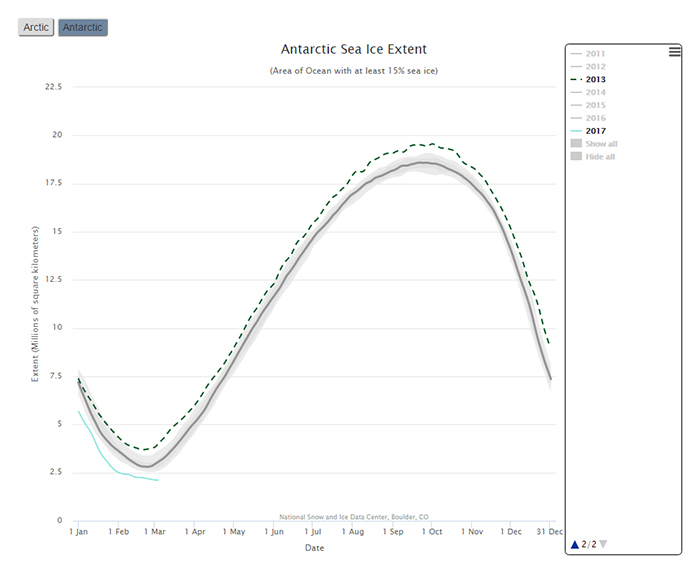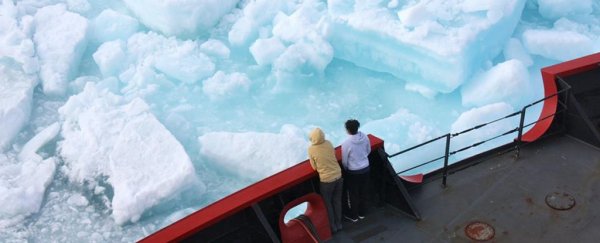There's less sea ice in the Antarctic this month than at any point over the last 38 years, according to the latest data, and scientists haven't been able to figure out exactly what's causing such a massive loss.
The 2.118 million square kilometres (817,800 square miles) of sea ice recorded on March 1 beats the previous 1997 record of 2.29 million square kilometres (884,200 square miles) by some margin – and it's the lowest measurement since satellite records began in 1979.
While ice has been rapidly disappearing from the Arctic at the North Pole, the levels at the South Pole in the Antarctic have been much more stable – until now. The new record follows a particularly bad summer for ice in the Southern Hemisphere.
The data is collected by the US National Snow and Ice Data Centre (NSIDC), with "sea ice extent" measured as the area of the Antarctic ocean with at least 15 percent ice coverage.
"It is very unusual," researcher Cecilia Bitz from the University of Washington told Maddie Stone at Gizmodo. Bitz says one contributing factor was lower-than-usual growth in sea ice at the end of the Southern Hemisphere's winter in 2016.
"It stalled out during the typical growth season, and then it just never got back on schedule. October losses were very high, and then, [by] early November, it was setting new records."
The next question is why growth stopped last year and has led to new lows in 2017. Figuring out the answer is important, because a reduction in sea ice could lead to a global increase in temperatures, with less white ice to reflect the Sun's rays back into space.
While global warming could be a factor, scientists say it won't be the only cause, because there are so many potential factors to weigh up.
"The Antarctic sea ice is so variable from year to year, it's hard to draw any firm conclusions from this record low," researcher Julienne Stroeve, from the US National Snow and Ice Data Centre, told Gizmodo.
"And summer is the most variable of all months in the Antarctic, so again just because this year is so low it doesn't mean it's related to climate change."
In short, it's complicated.
 Recent sea ice data from NSIDC, with 2017 levels in light blue.
Recent sea ice data from NSIDC, with 2017 levels in light blue.
Previous research has looked at how wind patterns, deep ocean currents, and the topography of Antarctica could be helping the continent hang on to more of its ice while coverage in the Arctic continues to shrink.
That's partly because the first ice growth of the season is moved away from land by natural winds and currents, creating a shield and encouraging conditions for further sea ice behind it.
This isn't as common in the Arctic, which is more closely surrounded by land masses.
Indeed, the level of sea ice in Antarctica in 2014 was the highest since satellite records began, so there's no evidence of a long-term decline just yet.
"We should not read too much in to this one data point by itself in this austral summer as one point in time is not sufficient regarding the climatic time scale of multiple decades," Son Nghiem from NASA's Jet Propulsion Laboratory told Gizmodo.
That doesn't mean we can be complacent about this new low in sea ice, NSIDC director Mark Serreze told Reuters last month.
"We've always thought of the Antarctic as the sleeping elephant starting to stir," he says. "Well, maybe it's starting to stir now."
You can take a look at the data for yourself on the NSIDC website.
